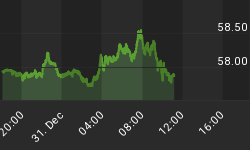Based on the September 4th, 2013 Premium Update. Visit our archives for more gold & silver articles.
According to Reuters, gold rose after President Barack Obama won the backing of key figures in the U.S. Congress, including Republicans, in his call for limited strikes on Syria to punish the government for its suspected use of chemical weapons against civilians. Earlier on Tuesday, a missile test by Israeli forces training in the Mediterranean with the U.S. Navy set nerves on edge. These circumstances stimulated safe-haven buying in the gold market and resulted in an increase in price to above $1,416 an ounce.
However, this improvement didn't last long. The yellow metal gave up some of its gains as the dollar rose after strong U.S. data boosted prospects the Federal Reserve would trim its stimulus this month. Despite this decline, prices held above $1,400 on continued concerns around Syria.
Speaking of Fed... markets are awaiting jobs data on Friday for clues on when the U.S. Federal Reserve will dial back its commodities-friendly stimulus measures that have helped push gold to record highs. However, the Fed meeting later this month will be much more important. It seems that as the days go and we approach this event, the precious metals market is getting nervous about a possible start to QE tapering and we see some price weakness.
In our previous essays we took a closer look at the situation in gold from different perspectives. In our essay on gold and the dollar on September 3, 2013 we wrote about the dollar's and the euro's implications for gold. At the end of August we also checked the stock market and the mining stocks for clues. In today's essay we want to introduce you to the copper and palladium charts. Why have we decided to feature these charts? Because commodities usually move together on a short-term basis, even though they may evolve into different formations in the medium- and long term. Do they provide us with interesting clues as to the next possible moves in the entire sector? Let's take a closer look at the charts below and find out. Let's start with the copper chart (charts courtesy by http://stockcharts.com).
On the above chart, we see that there was another short-term pullback in the past few days. This upward move took copper to the neck level of the bearish head-and-shoulders pattern once again; however, there was no breakout above it, and the price of copper declined shortly after this neck level was reached. What this means is that nothing has changed as far as the bearish implications of this pattern are concerned.
From this point of view, it was just another pullback, which did not invalidate the previous large head-and-shoulders pattern or its implications.
Consequently, the medium-term outlook for copper remains bearish.
Now, let's move on to the palladium chart.

On the above chart, we see that palladium moved above its upper resistance line (marked with a dashed line on the chart) in the first half of August. However, the improvement didn't last long, and palladium moved back below this resistance line in the following week.
Last week we saw further deterioration as the price of palladium dropped below the declining resistance line based on the 2013 top and the May peak (in terms of weekly closing prices).
From this point of view, we have an invalidation of two breakouts, which is a bearish signal. This is likely to result in further declines, and the implications for the rest of the precious metals sector are therefore bearish as well.
Summing up, as you know from our previous essay, the medium-term outlook for gold remains bearish despite a recent show of strength. Additionally, Tuesday's strength didn't change anything in the overall outlook. Taking into account the situation in copper and palladium and their implications for gold, it seems that the rally that we have seen in recent weeks was just a correction and that the metals will move much lower in the coming weeks.
Thank you for reading. Have a great and profitable week!
To make sure that you are notified once the new features are implemented, and get immediate access to our free thoughts on the market, including information not available publicly, we urge you to sign up for our free gold newsletter. Sign up today and you'll also get free, 7-day access to the Premium Sections on our website, including valuable tools and charts dedicated to serious Precious Metals Investors and Traders along with our 14 best gold investment practices. It's free and you may unsubscribe at any time.

















